People are a continually fascinating source of subject matter. Photographers shoot pictures of people for a variety of reasons. Many of you likely want to document the changing scene of life around you — children growing up, family gatherings, or special moments with those you love. Others enjoy photographing people as a means of self-expression, while other individuals make their living by doing portraiture, weddings, or photographing people for advertising and editorial venues. When people are the subjects of photographs, it's usually their faces that hold our interest, as the human face is capable of an endless variety of expressions. Many of these expressions are fleeting, and photographers try to capture these moments before they disappear. Other times, people want to be memorialized in a formal portrait session. And, sometimes you don't even need to see the face to understand the power of the photograph. No matter what the motivation is for doing portraiture, photographs of people tend to touch us more deeply than other subjects.
"African Soul"
© Marie Preaud
South Portland, Maine www.mariepreaud.com

When you shoot a portrait of a child in an informal setting, try to find props or a background that reveals something about him/her. In this case, the photographer wanted to make a statement about hope by asking the little boy to look up at the sky. Kids can be very cooperative subjects if you explain what you want them to do, and if you make the photo session fun. Children's attention spans are brief, however, so plan your photo shoot accordingly.
"A good friend of mine knew Louis' mother. He had told me how this little boy's soul was very deep and his green eyes were so beautiful. When I met Louis for the first time, I felt close to him. I asked him if he wanted to be photographed, and he allowed me to photograph him in such a calm, relaxed way. I knew he had been going through some emotional times, so I asked him to look up to symbolize hope. I will never forget the presence of this beautiful boy — he was wise for his age. A German record company (Blue Flame) later asked me to donate this photo for use on a cover of an album called 'Children Need Love.' They gave Louis 30% of the sales in order to give him savings for his education. This photograph means a lot to me."
Nikon FM2 35mm SLR
Nikkor 50mm lens
ISO 100 film
1/125 of a second at f/11
Natural light with a reflector
As I've mentioned earlier, you often get the best images of a child when he or she is unaware of the camera. If you keep your camera handy and use it often, a child comes to consider it a normal part of life. This photographer captured this little girl's sweet, fleeting glance, and she doesn't appear to be aware that her photo was taken. Only a portion of her face is revealed, giving this image a very natural feeling. I also like the use of negative space that she's facing. By using a relatively fast ISO and shutter speed, as this photographer did, you can freeze action, which gives you great freedom in capturing brief moments and quickly moving children.
"I was photographing a client who happened to be an old friend from childhood, and who I hadn't seen in many years. Her kids are mostly grown up, but this little girl is one of her daughters. The moment just struck me. Although it's pretty reminiscent of my shooting style, this image really penetrates. I took it at Huntington Beach, California, around 6:30 a.m. when the light is just so soft and beautiful. All the images taken during this sitting are gorgeous. It's amazing to me how we remember our children — for me, it's rarely a full frontal portrait, but rather a glimpse of a passing moment. I think this photo reflects this vision."
Canon EOS 20D digital SLR
Canon EF 50mm f/1.4 lens
1/1000 of a second at f/3.5
ISO 400
Early morning light
"Square Eye Photography II"
© Edna Eudave
Anaheim, California www.squareeyephoto.com
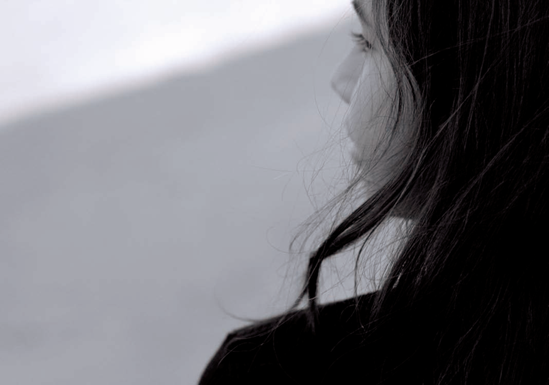
"Natalia"
© Christine McDonough
Salt Lake City, Utah www.ChristineMcD.com
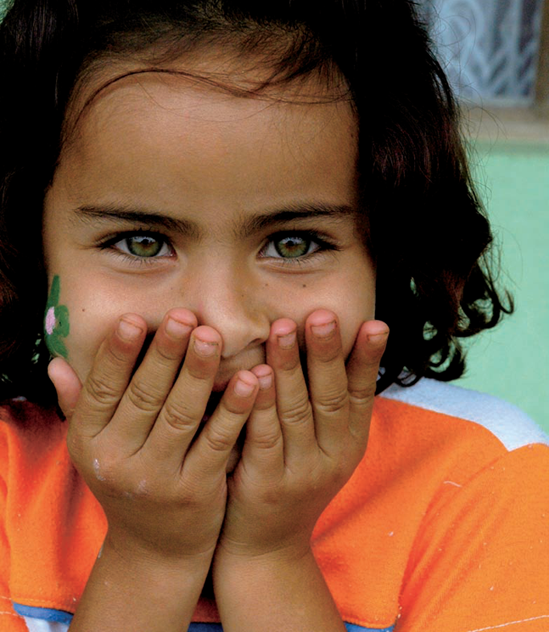
Although she's looking right at the camera, the adorable little girl in this tightly framed portrait reveals an appealing shyness. Her hands hide most of her face, but her eyes show some excitement about being photographed. Children are often playful and clown around for the camera, but they are just as cute when they show a little bashfulness in front of the camera.
"In the summer of 2006, I went with a group to Costa Rica on a Habitat for Humanity Global Village build. For a week, we worked daily with the families who were to live in the homes we helped build, and found some of the most congenial, hardworking, and beautiful people. While we worked, we also played with the neighborhood kids, who had a most special kind of beauty and joy. The first Spanish phrase I used was 'Puedo sacar una foto?' (May I take a photo?), and most people in the neighborhood would see my camera, run over excitedly, and pose themselves or their children for many pictures. Everyone was eager to see their image on the digital screen, and they would laugh and giggle, then insist on posing for more!"
Nikon D70 digital SLR
Nikkor 18–70mm f/3.5–4.5G ED-IF AF-S DX zoom lens set at 52mm
1/160 of a second at f/6.3
ISO 800
Natural light
As subjects for informal portraits, children can often be more rewarding than adults. Grown-ups tend to approach the camera with a fixed set of behavioral patterns. In contrast, children are much more natural. They're at a stage in their lives when their individuality is just emerging, and they're imaginative and spontaneous. Kids can display complete innocence in some areas, along with great sophistication in others. This appealing little girl seems friendly and unafraid of the camera's presence. The photographer captured her personality beautifully. It's best to try to portray a child's natural charm than to ask them to grin and assume a stiff pose for the camera.
"This shot was made during the holidays with my family at a farm in Jutland, Denmark. Heidi is my cousin's daughter and she joined the other kids in this Finnish wooden hot tub on Christmas Day. I didn't take a dip myself, but was outside with my camera because I thought that the cold air and steaming water might produce exciting soft lighting conditions under an overcast sky. I take a lot of pictures of the kids, so they're used to me behind the camera, poking the lens in their faces. I got about 15 really good shots of Heidi with different expressions. I chose this image because of her beautiful face and the confidence she revealed at that particular moment."
Canon EOS 5D digital SLR
Canon EF 24–70mm f/2.8 zoom lens set at 63mm
1/45 of a second at f/5.7
ISO 640
Overcast daylight
"Heidi"
© Steen Knarberg
Naestved, Denmark www.shade-n-light.com
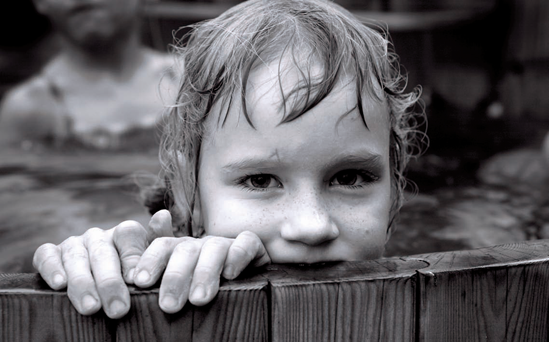

"Scott"
© Eric May
Nashville, Tennessee www.ericmay.net
To many, a portrait is simply a head-and-shoulders shot of an individual. However, this interpretive portrait brings an outdoor environment into the image, in which the subject is a small part. The man in this photo is separated from the background by side lighting, which spotlights him in this dark, natural setting. If you want to include a person in their surroundings or one of your choosing, you should decide how to use this broader surrounding to make a statement about the subject. Make sure the background adds something to the photograph; otherwise it will detract from your true subject, the person. Look for strong design elements like shapes, lines and patterns. Be aware that every element in a photo, no matter how small, plays a part in the overall impact of the image. Here, the photographer appears to be making a statement about the subject in a natural world. This portrait represents a very intriguing, original idea — and one that's rife with mystery.
"This image is a portrait of a friend of mine. I wanted to show him how I perceive him from my eyes. I asked him to pose for this photo as a personal image for my portfolio."
Canon EOS 5D digital SLR
Canon EF 24–105 L series zoom lens set at 28mm
1/125 of a second at f/11
ISO 100
Profoto Acute 1200R strobe
The young woman's eyes are the primary focus in this photo, and the photographer has rendered the rest of the photograph softly. Her face seems expressive and very natural. This photographer obviously puts a lot of thought into the way she wants to shoot her portrait subjects. To capture the essence of a person, you must try to show the qualities that make that person unique. It's also important to learn to assess a subject for the greatest visual impact. Your photos will be more satisfying for you because they'll reflect the image as you saw it when you clicked the shutter. It will also help you develop your photographic style. If you know how you want to portray a subject, and what qualities you want to show, your images will have far greater emotional impact for those who look at them.
"Nicole is my younger sister, who is used to being photographed by me. I enjoy photographing her face and her big blue eyes. I used the natural daylight in the room, which allowed me to capture the eyes so clearly and the soft shadows in her face."
Canon 350D digital SLR
Canon EF 85mm lens
1/500 of a second at f/1.8
ISO 400
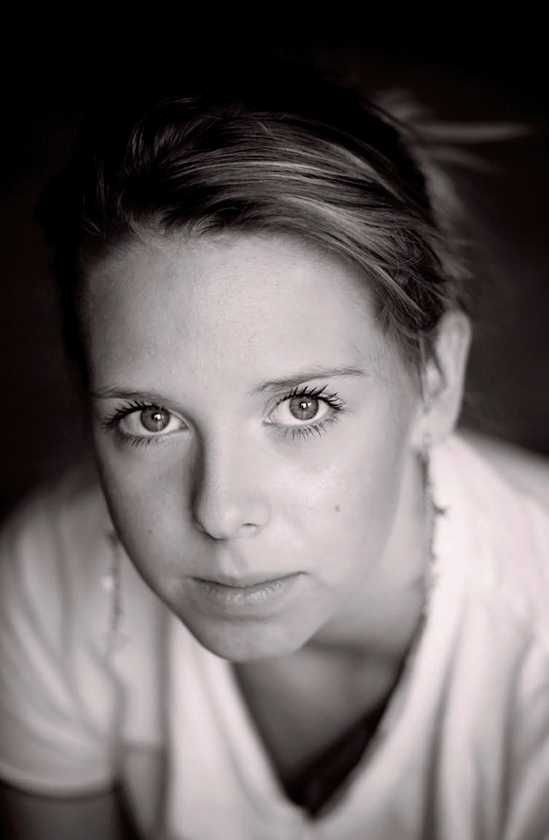
"Nicole"
© Monika Manowska
Nacka, Sweden
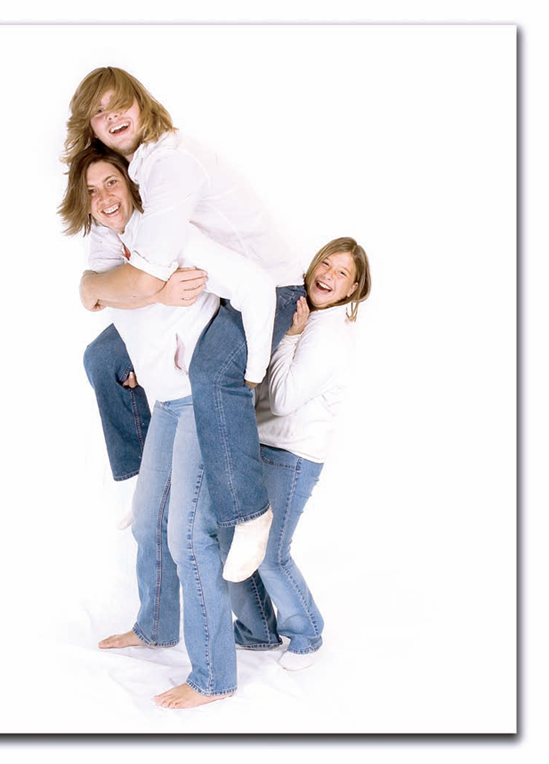
Window light
"Family"
© Eleanor Caputo
Jackson, California www.studio18gallery.com
Most formal family portraits show parents and children posed together, but few show much of people's personalities. By contrast, this family looks like they're having a great time in front of the photographer's camera. Whether you choose to portray a group of people in a formal or informal manner, however, you should try to arrange them in a dynamic way. Have some family members sitting, kneeling, or standing at a higher level for more pleasing visual variety. The positions of their heads should appear to be in a staggered pattern or in a triangular design, instead of heads lined up in a row, which can appear stiff and static.
"This is Kari and her two children. The boy on her back is Jordan, who is in high school, and Brett is the one giving a helping hand. This family is so much fun and they interact so well. This was a moment that was completely candid, and I prefer to shoot unposed, candid portraits. Jordan unexpectedly jumped on Kari's back and Brett jumped right in there to give him a boost. People ask me where I want them to stand, and I tell them that I just want them to interact as a family so I can capture their true relationships as a family unit. I ask them to bring their favorite music CD and we just get into it. Those are the images they love best."
Canon EOS 10D digital SLR
Canon EF 17–40mm L zoom lens
1/60 of a second at f/10
ISO 100
Two Britek PS-300H studio strobes with softboxes and a Britek umbrella light to overexpose the background for high-key lighting
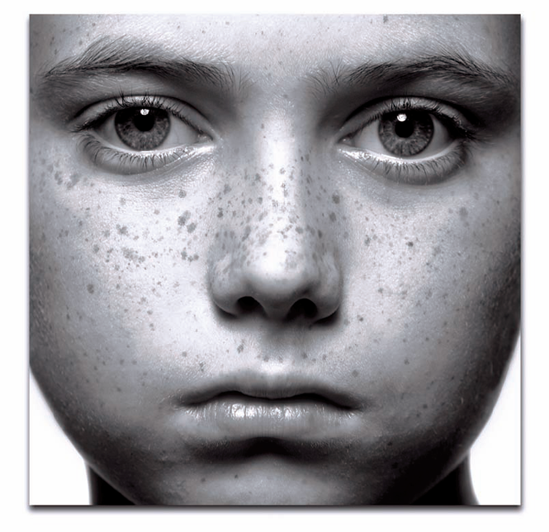
"Devon"
© Patrick Lanham
St. Louis, Missouri www.lanhamphotography.com
Photographs of people can convey a multitude of messages. You can look at the same photo over and over again and find some new meaning to it. For you as a photographer, an image can be a way of communicating a message to viewers. Whether your subjects are corporate executives or neighborhood children, the camera is a tool that allows you to express what you're feeling about the person you're photographing. This very tightly cropped image emphasizes the very direct gaze of a child, and from the photographer's point of view, a trip down memory lane.
"Devon is a portrait of my nephew, which is part of my series of portraits entitled 'Faces.' I have always been fascinated by people's faces from my early years in figure drawing classes, and have turned to photography to capture that realism that I've always wanted to get with my drawings. This series of portraits features faces closely cropped to show eyes, nose and mouth, the three areas of the face that are the most relevant to one's own character. I chose Devon because of how simple and quiet he looked, and the beautiful pattern of freckles on his face. He looks so much like his father when he was 11 years old; I feel like I'm looking into the past."
Canon EOS 1D Mark II digital SLR
Canon 70–200mm EF zoom lens set at 200mm
1/125 of a second at f/8
ISO 50
Single Broncolor Softlight reflector directly overhead, about 45 degrees, with diffusion
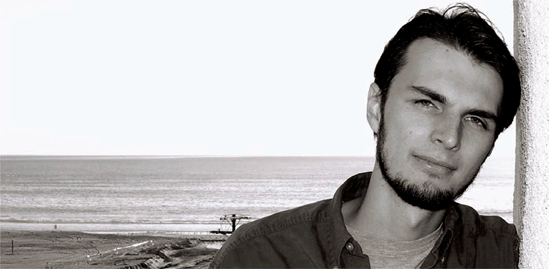
"Subtle Melancholia"
© Jonny Kahleyn
Santa Monica, California www.juhannusproductions.com/photo
To create a successful photo, you must make a few decisions beforehand about composition—where to position the subject within the frame, what other elements to include, and whether to frame the image horizontally or vertically. Traditional portraits are usually taken in a vertical format, whether they're full-length images or tight close-ups. However, this photographer chose to position his portrait subject on the far right of the frame in a wide, horizontal format. As opposed to positioning your subject dead-center, an image will have much more impact when the subject is off-center. Also, the use of fill-flash illuminates the man's face nicely. Without it, he would probably be rendered in silhouette.
"Andy Anderson and I are part of the same theatre group in Los Angeles. Late last year, I offered to shoot some pictures that he could use as headshots. The only camera I had available on the day of our shoot was my first camera (and one of lucky charms), the very basic FujiFilm S5 100. It was almost sunset with lots of warm light when I took this picture. His soulful eyes emanated a feeling of subtle melancholy that my little camera captured beautifully."
FujiFilm S5100 compact digital camera
Built-in Fujinon zoom lens set at 57mm
ND filter
1/80 of a second at f/3.1
ISO 100
Natural light combined with fill flash from the camera's built-in flash unit
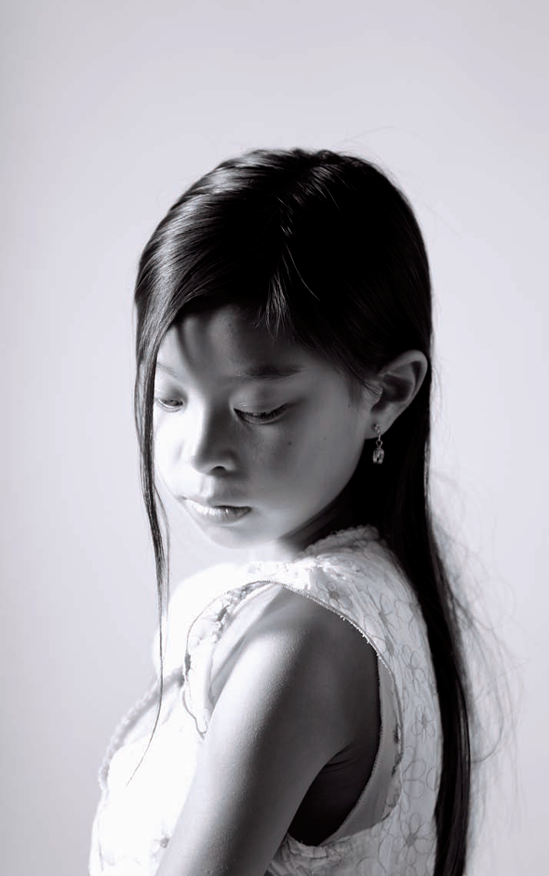
"Aiko"
© Ronnie Benjamin
Fairfield, California
You don't always have to portray people smiling and happy in your photographs. There may be times when you'll prefer to capture a mood, such as this photographer did by capturing this little girl's pensive, downcast look. To put mood in your photographs, you might begin by recognizing what visual elements best interpret how the subject is feeling, and how a viewer may feel when they look at the photograph. Perhaps it's a facial expression or body position. Remember that mood is a personal thing, and can be determined partly by a viewer's own interpretation of a picture. Whatever feelings a picture may evoke — perhaps sadness, joy or anger — they're usually enhanced by our own personal interpretations.
"Aiko is half Japanese and half Filipino, and she is my niece. My wife was babysitting for her brother at our house where I also have a studio. When I saw Aiko looking a little bored, I asked her if she would pose for me while I experimented photographically without strobe lights. She agreed, and I shot around 10 images that day. The following day she came back wearing a nice dress, and I took more pictures. I gave my brother-in-law two 8 × 10 prints as a way of saying 'thank you.' This image hangs on their wall."
Canon EOS 20D digital SLR
Canon EF 70–200mm f/2.8L zoom lens set at 200mm
1/125 of a second at f/2.8
ISO 200
Window light with a reflector used to bounce light on the shadow side of the subject
"Snow Angel"
© Lisa Butler
Tulsa, Oklahoma http://lisabutler.photoworkshop.com

This studio portrait utilizes some very pleasing, soft light from a softbox and a tight close-up of a cute little girl. The high-key white of her hooded sweater surrounding her face draws the viewer's eye in to her face and appealing smile. There are many ways to light a subject, but to keep it simple, one main light is often all you'll need. When shooting a formal portrait, always remember that the best backdrop is a simple and uncluttered one. Most commonly used ones include a plain wall, fabric or seamless paper background. But whether you're indoors or outside, make sure that the background won't distract from your subject. It's always best to photograph children at their level, and a moderate telephoto lens (at least 50mm with a digital camera) is always a good choice for a portrait.
"I captured this image during our children's Christmas portrait shoot. During any photo session, I am always drawn to the person's eyes — they are truly a window to the soul. While taking pictures of Courtney, all I could think of was how angelic her eyes were. To me, she looked like a snow angel, thus the title of this photo."
Canon EOS 30D digital SLR
Canon EF 50mm lens
1/100 of a second at f/9
ISO 100
3 × 5 Softbox with a B800 Strobe from AlienBees
Of all the photos taken on a couple's wedding day, candid moments often result in the most treasured images. If you're shooting a wedding, you can take a photojournalistic approach, which is a very popular style of wedding photography today. The couple and their families understandably want you to shoot events like the march down the aisle, bride and groom's first kiss, cutting of the cake, and so on. But you should also be ready to react quickly if a lovely candid opportunity arises, like this one. Wedding guests are usually very busy and preoccupied, which gives you a variety of candid scenes to shoot, and makes it easy to work unnoticed. A telephoto zoom brings people's faces in close so that you can take a fly-on-the-wall approach.
"I book about five weddings per year and shoot photos for the Renfrew Soccer League. I still consider myself an amateur photographer, and my favorite saying when speaking to camera clubs is, 'Professionals built the Titanic, but amateurs built the Ark.' I took this picture at a wedding near Cobden, Ontario, after photographing the bride and her flower girl. I was just starting to pack up my equipment when I caught this special moment out of the corner of my eye, and quickly fired the shutter."
Canon EOS 620 35mm SLR
Canon EF 28–105mm f/3.4–4.5 zoom lens
1/250 of a second at f/5.6
Kodak Portra 400UC color film
Canon Speedlite 430EX with a LumiQuest
ProMax Softbox
"Special Moment"
© J.J. Guy Longtin
Renfrew, Ontario, Canada http://guy_longtin.photoworkshop.com
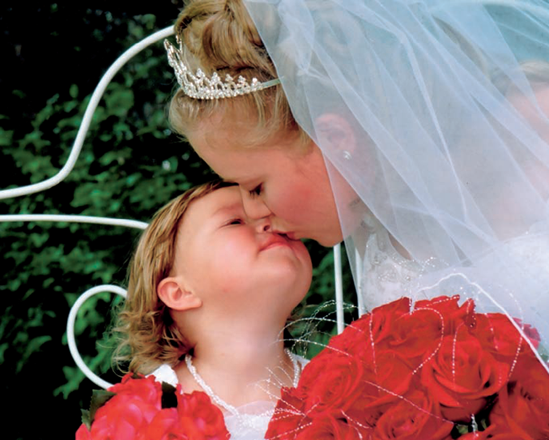
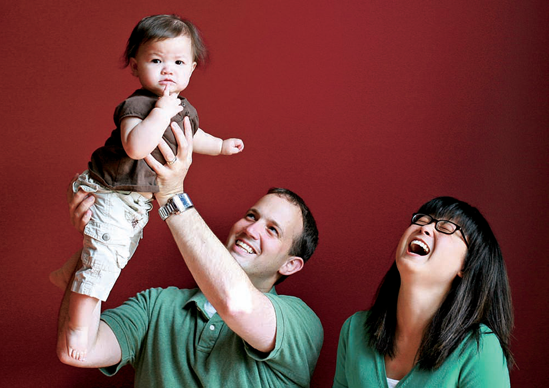
"Family Portrait"
© Stacy Wasmuth
Indianapolis, Indiana www.bluecandyphotography.com
Many family portrait sessions are carefully posed and don't tell the viewer much about the people in the picture. This one, however, shows us happy parents with an adorable child, people I'd probably enjoy meeting. It's a departure from the formal poses that most portrait studios shoot, in which the three people would form somewhat of a triangular composition. When photographing a family, you might first want to shoot some formal, posed portraits. You can instruct some family members to sit and others to stand to create an attractive arrangement. Then, ask the family to interact with each other for more spontaneous images. These will undoubtedly show something of the subjects' personalities and their relationship with one another, besides possibly being the best-loved photos you shoot of them all day.
"I love family portraits with personality. When photographing families, I typically encourage them to interact playfully rather than pose for the camera. This mom and dad first played patty-cake with their daughter, which resulted in a few fun shots. But as often happens with babies of this age, she quickly squirmed to be put down on the ground. I asked her dad if she enjoyed being bounced or lifted into the air. My suggestion led to this capture — an adorably bewildered baby and natural joy on her parents' faces."
Canon EOS 5D digital SLR
Canon EF 50mm lens
1/250 at f/3.5
ISO 400
Window light
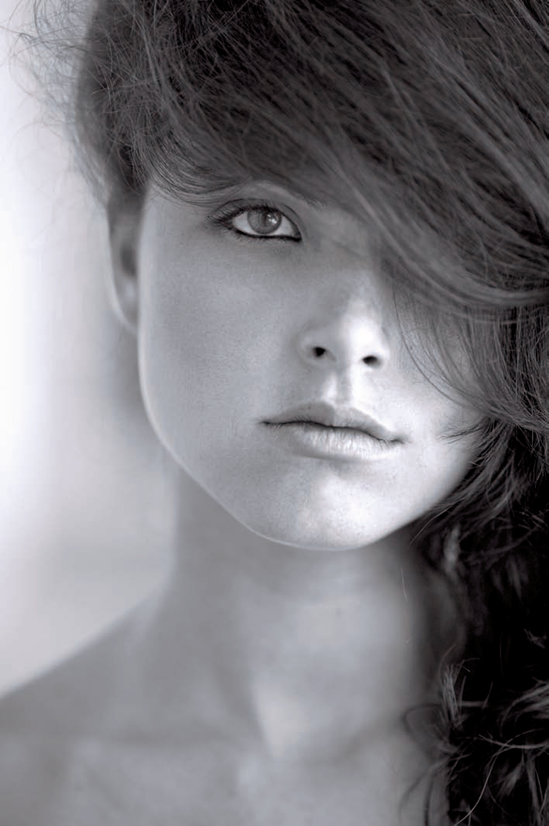
"Janny"
© Bryan Benoit
Miami, Florida www.bryanbenoit.com
Not all portraits have to be created in completely controlled settings. After your more-formal portraits (or in place of them), when the model is relaxed and feeling comfortable in front of the lens, try shooting a few informal portraits. What you lose in a controlled lighting situation may result in fresher, more spontaneous images. You also can concentrate more on capturing natural expressions than when you're concerned with the details of lighting and posing a model. In this situation, try to utilize natural light as much as possible. By taking pictures on a lightly cloudy day or in the shade of a building, you'll get soft, diffuse light that will give your subject flattering illumination. Look for backgrounds where you can utilize light-colored walls to bounce a little light back onto the subject's face."
"This image was taken during a portfolio development session, and it was one of the last photos taken that day. While the model was rearranging her hair, I noticed the effect and wanted to photograph it. Her piercing eyes make the image. What you can't see is her friend, who's holding her hair in place just outside the frame. I converted the image to black-and-white to accentuate her eye that's revealed here and used a fast lens to minimize the depth of field."
Canon EOS 5D digital SLR
Canon EF 135mm f/2.0
L series lens
1/400 of a second at f/2.5
ISO 160
Natural light in open shade
A lot of people enjoy shooting spontaneous pictures of people in busy urban areas. Candid — or street photography — as it's sometimes called, is usually done discreetly and photographers often take great care to avoid tipping off a subject. Others talk to their subjects and create a rapport before shooting pictures. To do street photography, you may want to find an interesting setting or event and look for interesting people to appear. Telephoto lenses help you keep your distance from wary subjects, but because of the inherent shallow depth of field that telephotos have, it's very important that your images are in focus. This photographer used an image-stabilizing lens to help alleviate that problem.
"I shot this image at Eastern Market in Detroit, Michigan. I photograph a lot of people candidly on the streets of Detroit, and am very respectful of anyone I approach. Joe Jones was an exception — I saw that face, walked over to him and said something like, 'I have to take your picture. Look that way!' He did this and I got a couple of exposures, but this one was the killer. I had been going in and out of the market changing my camera settings, but as we all do sometimes, we forget to make the correct alterations until we shoot again and look at the results on the back of the camera. Fortunately, I was ready for this one."
Canon 20D digital SLR
Canon EF 28–135mm IS zoom lens
1/125 of a second at f/8
ISO 800
Natural light
"Joe Jones"
© Bruce Giffin
Dearborn Heights, Michigan www.brucegiffin.com
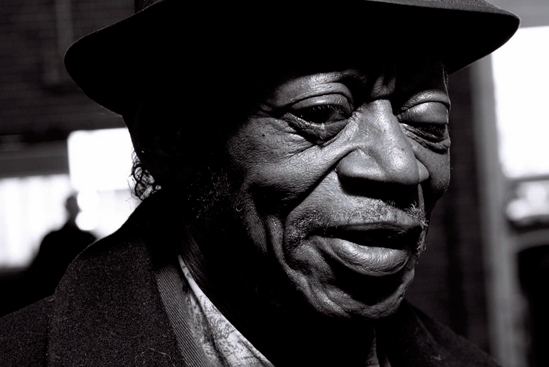
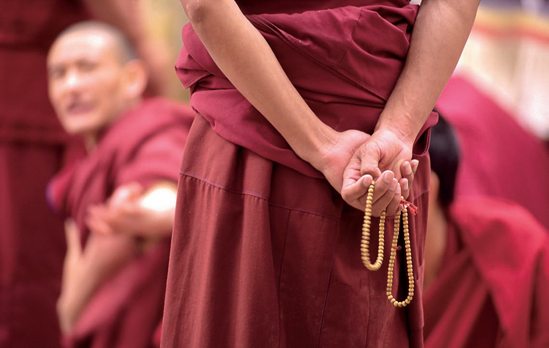
"Beads"
© Gerald Oar
Olympia, Washington www.geraldoar.com
Although portraiture has been traditionally about people's faces, there's no rule that every photograph of a person must reveal one's face. This portrait speaks volumes about tradition in a Buddhist Monastery even without recognizable people. More importantly, this photographer captured a special moment, which is one of the greatest challenges of photographing people. In journalistic photography, timing is crucial to get a picture that best tells the story. You need to see the perfect moment before you can shoot it. Better yet, you must learn to anticipate it, to have your image planned and your camera ready when the elements of a scene come together.
"One of my main destinations in Tibet was to visit the Sera Monastery. It's known for its Debating Courtyard where roughly 100 monks gather to test each other in their knowledge of the Buddhist scripture. This is done by pairing off into groups of two and then the questioner shouts his question at the other monk while loudly clapping his hands in his face and cajoling him while he attempts to reply. After approximately ten questions, they exchange positions. This photo is an example of a portrait without showing faces. I specifically used a shallow depth of field and tight framing to isolate the hands and the beads of the monk in the foreground, while keeping the blurred monk in the background to document the two characters' interaction."
Nikon F100 35mm SLR
Nikkor 80–200mm f/2.8 zoom lens
Fujichrome Provia film
Exposure unrecorded
ISO 100
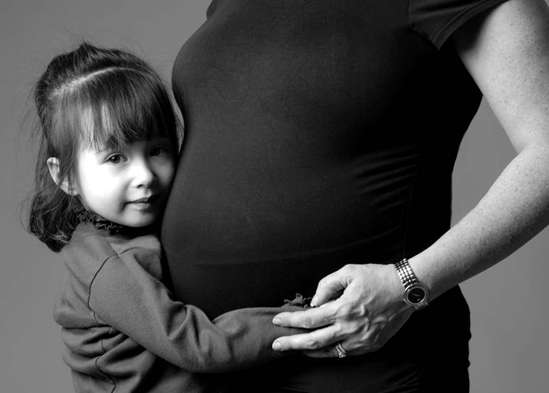
"Untitled"
© Lisa Klare
Northfield, Illinois
The relationship between parent and child is like no other, as beautifully portrayed in this child's face as she hugs her pregnant mother. Small children are usually naturally affectionate with a parent in a portrait sitting. This image shows a moment in time, a milestone in the life of this growing family. Also apparent is the love that this little girl has for her mother, whose affections she will soon have to share with a sibling. Family pictures are priceless —they show who we are and bring back memories of how we look at different times in our lives.
"This session was initially planned as a maternity and mom and toddler photo shoot. The images I took were going to be part of a photo birth announcement. As we got into the session, however, I was struck by the innocence and vulnerability of two-year-old Samantha in the waning weeks of being her mom's only child. In just a couple of months she would no longer have her mom all to herself. I wanted to capture the mix of feelings inherent in this period of profound change. The remainder of the birth announcement held a happy group photo of Samantha with her mom, dad, stepbrother and stepsister, as well as a close-up picture of the new baby.
Nikon D200 digital SLR
Nikkor 24–120mm zoom lens set at 62mm
1/125 of a second at f/11
ISO 100
One Speedotron Brown Line D1204 M11 flash head set at 1/4 power with a Photoflex Lite Dome XTC softbox
"Alex"
© Sally Haines
Cape Town, South Africa
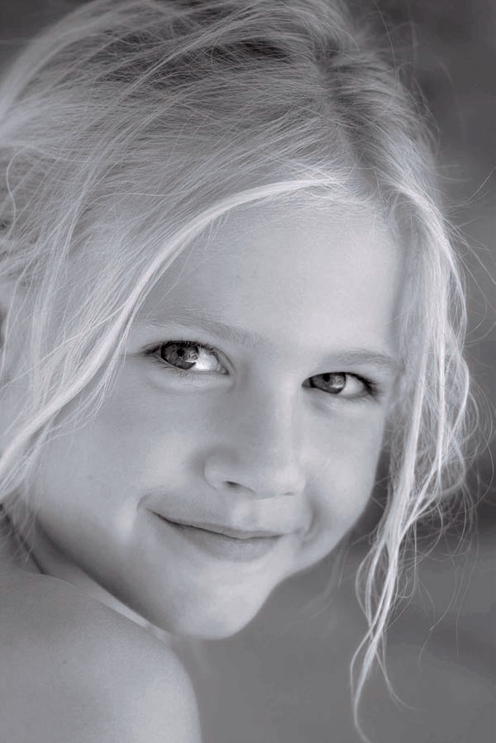
Children seem to supply a never-ending supply of cute expressions, gestures and poses for the camera. Capturing a close-up of the face captures all the details around the eyes and a person's unique expression. And close-ups are especially fun with children because of their unguarded nature. If you're photographing a child outside on a sunny day, be sure to take pictures in an area where there's open shade, perhaps the side of a building or under a tree. Since children are small, be sure to move in close or use a moderate telephoto lens (about 50–105mm with a digital camera) so that their image fills the frame. This focal length range will allow you to keep enough of a distance to shoot candids, but won't be too long and awkward. Most importantly, keep your camera handy and be ready to click the shutter at an opportune moment, like this photographer did.
"This picture was taken after Alex had been swimming and her hair had fallen so naturally around her face. The sunlight was falling perfectly on her, so I decided to sneak a picture, but without her knowing and posing for the camera. Once I pretended to be doing something else with the camera, I called her and she turned toward me and gave me a sweet smile."
Sigma SD10 digital SLR
Sigma 105mm macro lens
1/500 of a second at f/2.8
ISO 200
Sunlight
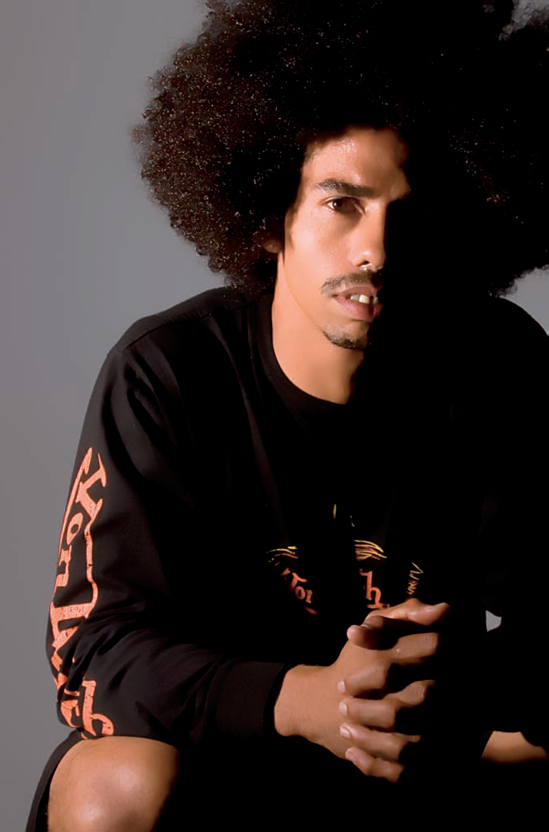
"Mark Anthony"
© Susan L. DeLuca
Valrico, Florida www.bloomingdalephotography.com
Highly directional lighting that comes from the side gives a lot of drama to this studio portrait of a young man. There are a variety of ways to light a subject, and these variations will greatly alter the appearance of a subject. In addition to setting up the lights, you must pay attention to the subject's pose. It's best to photograph a person who's natural and relaxed in front of the lens. Keep in mind that a subject leaning slightly forward, like this one, seems more at ease. Someone leaning back can appear more reserved and distant. You'll want to click the shutter only when the posture, tilt of the head, and the expression appeal to you.
"At 57, I was the oldest among all the young people starting a studio lighting class while working toward a photography certificate at University of Southern Florida. The professor brought a student into the studio area and started to show us how lighting works. Every time he did something different with the lights, I kept seeing a photo in my mind's eye to the point where I couldn't stand it anymore. I stood up and blurted in front of the whole class, 'Can I please take his picture right now?' Everyone laughed, including the professor. The result is this photo of Mark Anthony and a passing grade in studio lighting."
Canon EOS 20D digital SLR
Canon EF 28–80mm zoom lens set at 52mm
1/125 of a second at f/11
ISO 100
Studio strobe lighting
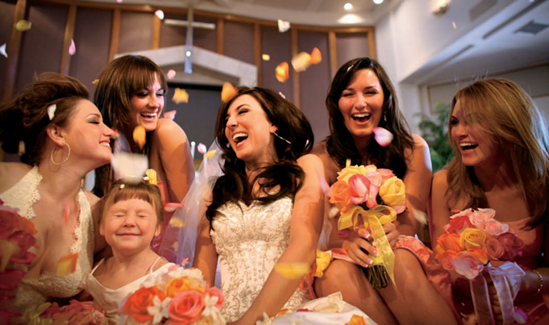
"Bridesmaids & Flowers"
© Scott Robert Lim
Monrovia, California www.scottrobertgallery.com
Weddings offer a wealth of photo opportunities, both candid and planned. As you can see here, not every photo of the wedding party needs to be posed and formal. This joyful image of the girls being showered with flower petals was the photographer's idea. Even though it's a set-up shot, it has a very spontaneous feeling. When photographing a group of people, it's very important that they form an attractive composition so that everyone's face can be clearly seen, which is the case in this image. When taking pictures of the wedding attendants, you can gather all of them for a portrait, then narrow them down while you work, ending with just the bride and her maid of honor if you like. And because he utilized the ambient room light with no flash, the photographer captured this image with a high ISO of 800.
"I had very little time to shoot some fun photos of the bridal party. I had just finished shooting all the formals and wanted to do something different, but I didn't have enough time to move the group to another location. I noticed the flower petals on the ground from the ceremony and thought it would be fun to shower the girls with flowers. I specifically instructed the girls to show extreme emotions of joy and laughter as the petals came down."
Canon EOS 5D digital SLR
Canon EF 24mm f/1.4L lens
1/200 at f/2.2
ISO 800
Ambient room light
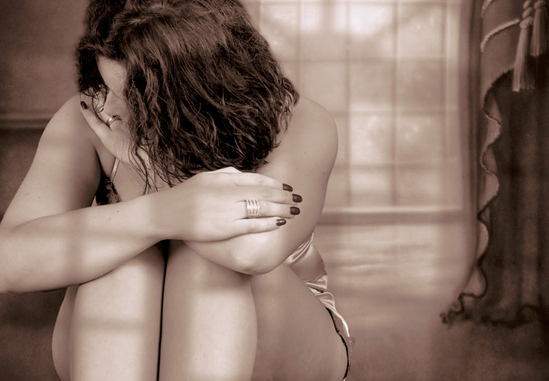
"Palace Prison"
© Steve Parrott
Jackson, Tennessee www.parrottimaging.com
Mood is the way a picture feels. Moods can be changeable, and even subtle differences alter the feel of an image. There are a number of ways to convey mood, and it's partly determined by the viewer's own interpretation of a photograph. The woman in this photograph seems to want to avoid the camera's gaze, and although she's not really in a prison, as the image title implies, the photographer has utilized the lighting and shadows to make her appear as if she is behind bars — a prisoner of her emotions, perhaps. I also like the placement of the subject off to the left side of the frame, revealing a little of the environment she's in.
"This woman wanted something different from the typical studio portrait. We shot many different poses, and while she was relaxing between shots, she took on this pose. I said, 'stay just like that!' I think the photo works well because the pose was just a natural state she was in at the time. I didn't have the finished product in mind when I shot this image, but I felt that the 'landscape' orientation would work better than the typical 'portrait' orientation."
Canon EOS 1Ds digital SLR
Canon EF 135mm f/2.0 L lens
1/100 of a second at f/5.6
ISO 100
One Adorama Flashpoint strobe with umbrella, positioned about 45 degrees left of the camera
This refreshing portrait is a contrast to those that are very posed and formal, and the photographer captured the subject's jovial spirit very well. She seems to be having such a good time that the audience also wants to hear the joke and join in the fun. Every photograph of a person conveys some sort of mood, whether it's happy or sad, and looking at other people can affect our emotions. Look at pictures of people and see what moods they evoke. Some may cause you to feel compassion, while others may conjure up anger. Some lighthearted images, like this one, draw you into the enthusiasm of the moment.
"People have always been my favorite subjects to photograph. This was one of my first studio shoots, and I was nervous. I kept tangling myself up in my cords and messed up the settings on the camera. I probably made every mistake that one could in this situation. During my nervousness, I suddenly became very talkative and simply could not shut up. Eventually, my babbling made Natasha (the model) burst into laughter. As the photo session progressed, my silly remarks kept on coming — until I realized how great the way she laughed was. I waited for her next outburst of giggles and captured it."
Canon EOS Digital Rebel XT
Canon EFS 18–55mm zoom lens set at 55mm
1/250 of a second at f/8
ISO 200
Two Esprit Gemini GM500 lights; one aimed at the model, one with a blue gel aimed at the background.
"Giggles"
© Jean-Christophe Demers
Montreal, Quebec, Canada http://jcdc.photoworkshop.com
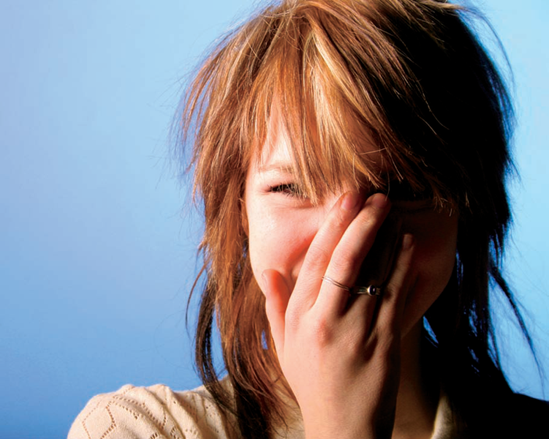
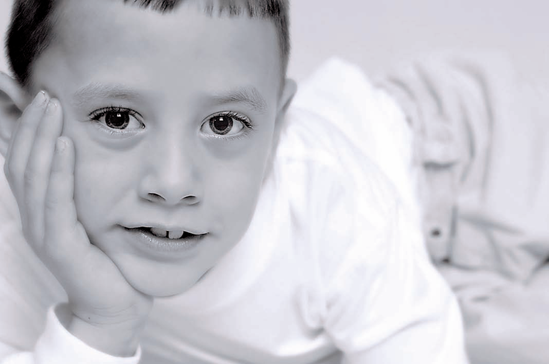
"Ben"
© Helen Miller
Adrian, Michigan
Without a doubt, the face is the most expressive part of the body. Thus, one of the easiest ways to capture a revealing portrait of a person is to concentrate on the face. A tight composition conveys a strong feeling of intimacy. This effect is accentuated when the subject looks directly at the camera, as we get the feeling of making eye contact with the person in the image. By concentrating solely on this little boy's face and throwing the rest of the image into a blur, we see something of his playful nature. Close-up portraits are very effective when photographing children, whose moods and expressions are often unguarded. It's also a good idea to get down on a child's level to photograph them, as this photographer did.
"This is a photo of a friend's son. My friend wanted some family photographs that were a little different, something that would reveal his children's personalities. I wanted to show his expression more than anything, so I focused only on his face. But I chose not to photograph him in the typical way that one shoots headshots of a person—I chose a more fun and creative way. Ben's white shirt reminds me of the angel that he is. He's such a good boy, and you can see that in this portrait."
Nikon D2HS digital SLR
Nikkor 24–85mm zoom lens set at 75mm
1/125 of a second at f/5
ISO 200
Softbox light directly over the photographer's head.
Sometimes, a person's posture or body language can say a lot about him or her, even when the face isn't revealed. On-camera flash is very useful for portraits in low-light situations, as flash emits a powerful amount of light that approximates the color of sunlight. But if the subject's face were part of this image, the direct light might have flattened out her features. In this photo, the flash provides just enough fill light to illuminate the young lady's arms and legs. The background appears dark, so we don't see much in the way of shadows that often characterize on-camera flash. When photographing people with flash indoors, you can soften the light with a piece of tissue, cloth or acetate. Many flash units come with a diffusing panel specifically for this purpose.
"This is a photograph of my daughter after she returned from a Homecoming Dance at school. She looked beautiful but very tired, and sat down in a chair to talk to me. I started taking pictures since my camera is never very far away. As I did so, she folded over to unfasten her shoes — and there was my shot. For me, a portrait is not honest unless it reveals something about the personality of the subject, and for me, this image conveys so much about her without even seeing her face."
Pentax MZ50 SLR
Pentax 35–80mm zoom lens
Fujichrome Provia transparency film
Exposure unrecorded
ISO 100
On-camera flash
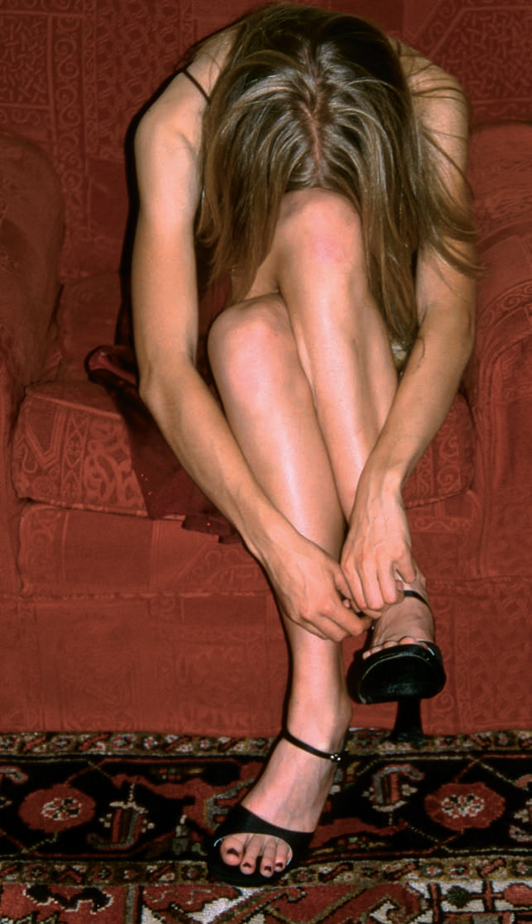
"After the Dance"
© Heather Maslen
Anchorage, Alaska http://heathermaslen_photography.photoworkshop.com
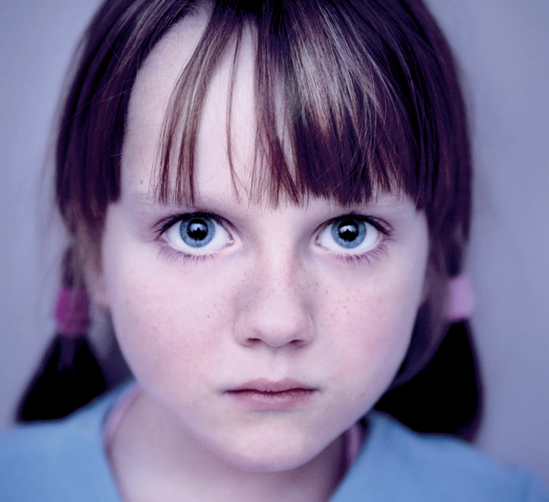
"Julia"
© Monika Manowska
Nacka, Sweden
Electronic flash can be a lifesaver in many photo situations, both indoors and outside. Compact and lightweight, dedicated flash emits a great amount of light that approximates the color of daylight. Rather than pointing your flash directly at a subject, try using a diffusing panel (many flash units come with this device), or bounce flash off a wall or ceiling to modify the light. When flash is bounced off a ceiling or wall, it spreads over a wide area and strikes the subject from many different angles, producing soft, even illumination. When light is bounced off a ceiling, it emulates room light from above. When it's bounced off a wall, it sometimes resembles soft window light. In this image, the photographer used flash indoors — as well as a very shallow depth of field — to emphasize this child's beautiful blue eyes. If you look closely at this (and other pictures taken with flash), you can see the flash in the subject's eyes, called a catch light.
"Julia is seven years old and is my friend's daughter. She is accustomed to being photographed and is very relaxed in front of the camera. She opens her eyes wide when she's having her picture taken. My intention was always to show her beautiful big blue eyes."
Canon EOS 5D digital SLR
Tamron 25–75mm lens set at 68mm
1/64 of a second at f/2.8
ISO 400
Canon EX430 flash unit
This is a very appealing portrait of two young brothers, but even more so, a unique portrayal of an up-and-coming newborn as part of the family unit. This is a very inventive way of including an unborn family member in a family portrait. I like the camera level at the children's perspective, as well as the impish smile of the boy who's holding up the image of the ultrasound. Natural looking portraits like this one still take a lot of planning, and the photographer engaged the little boys in conversation to get some great expressions and draw out their reactions to the new sibling. The soft, yet directional light creates very effective separation between the children and the background.
"Because I enjoy documenting family milestones, I hoped to capture the evolving family relationship for these two brothers by incorporating their new sibling's first ultrasound. I chose a simple background and clothing to bring the focus to the subjects and used directional lighting to give depth and mood to the photo. An antique table placed directly next to a window raised my little subjects to sit in the perfect light. As I asked the older brother to show me the image of his newest sibling, I talked to both of the boys about how they felt about the family's new addition. The resulting image of an exuberant older brother and a pensive younger brother was priceless."
Canon EOS 5D digital SLR
Canon EF 85mm lens
1/250 at f/3.2
ISO 500
Natural window light
"A New Addition"
© Stacy Wasmuth
Indianapolis, Indiana www.bluecandyphotography.com
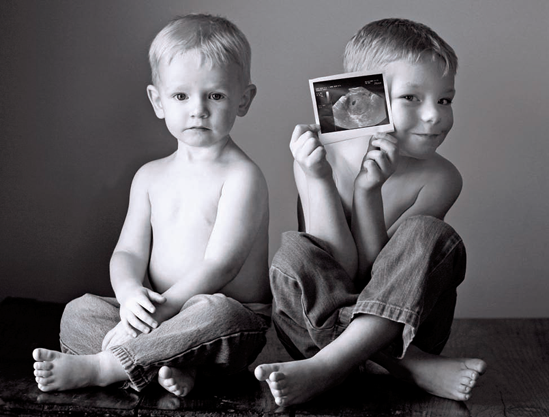
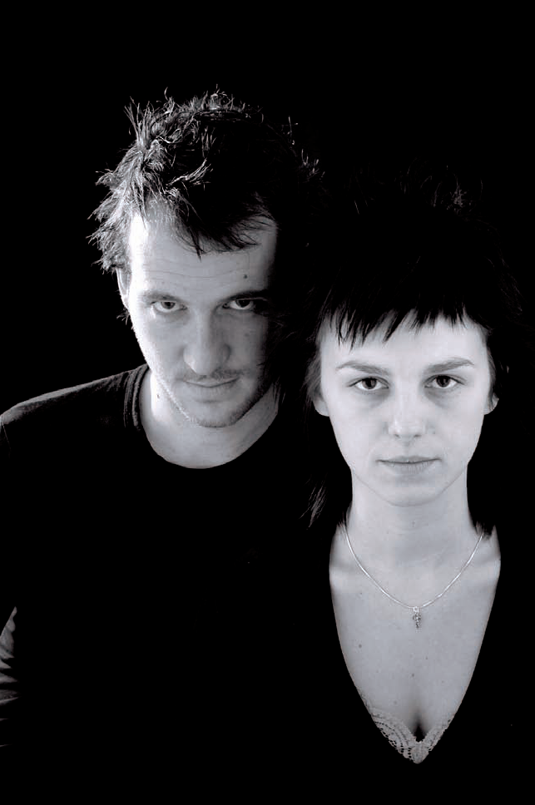
"Stef"
© Ann Snoeck
Bruges, Belgium
Although this couple is looking directly into the camera rather than at one another, there's still a sense of subtle intimacy between them because of the close proximity of their faces and the expression in their eyes. When photographing a couple, your goal should be to capture the feelings between them, whether it's in a posed portrait or candid shot. You don't want people to be standing stiffly in front of the camera. In a posed portrait, it's best to create a composition that's pleasing to the eye with one subject just slightly higher in the frame than the other. In this case, the man's mouth is aligned with the woman's eyes, which is generally a good way to portray two people together. You can also have the man stand on a step just behind the woman.
"The picture was taken for this couple's wedding invitation. With few words, they gave me carte blanche to 'do whatever you feel!' Because these two people have something special and mysterious, I make them speak in this image with their eyes. I used a very small photo studio for this photo session. There was one softbox light behind the couple, and two reflection panels placed diagonally in front of them. I measured the reflected light off the panels on their faces."
Nikon D100 digital SLR
Nikkor 24–120mm f/3.5–4.5G ED-IF
VR zoom lens set at 70mm
1/60 of a second at f/5.6
ISO 200
Studio lighting
"Hockey Player"
© Yves Rubin
Los Angeles, California www.rubinphoto.com
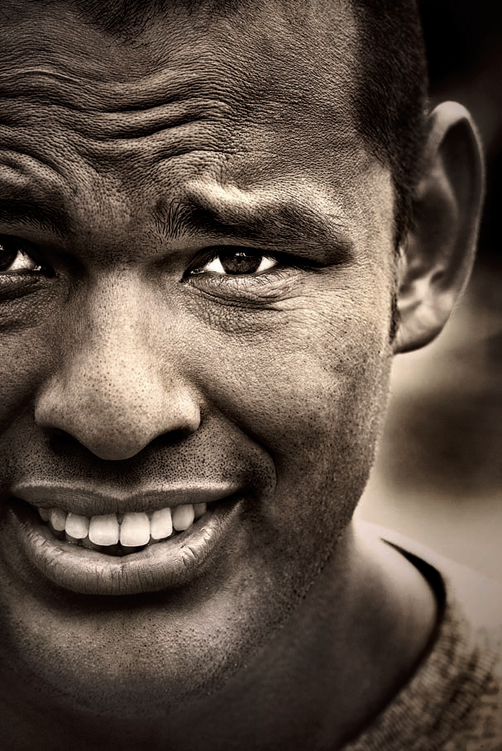
A person's facial expression can speak volumes about what they're feeling, and often reveals something about his or her personality. Faces are capable of a vast array of expression, much of it subtle and fleeting. So often, we don't study people's faces, especially those of people we already know, and we don't notice their changing expressions. To capture the essence of an individual, you must reveal the qualities that make that person distinct, as well as those qualities to which others can relate. This unique image is cropped in very close to emphasize the hockey player's intense expression after playing a rousing game on a hot day, and says far more about this young man's passion for the sport than would a portrait of him grinning at the camera.
"The subject and I play rollerblade hockey together. After a hard-fought game on a rather hot Southern California morning, Edward's intense expression from the play was striking. Although I took this picture under a hazy midday sky, light happened to be well-suited for the intensity of his expression. I intended to render this picture in a monotone or black-and-white from the start."
Canon EOS 1Ds Mark II digital SLR
Canon EF 70–300mm f/4.5–5.6 DO IS USM
Zoom lens set at 260mm
ISO 200
1/40 of a second at f/11
Natural light
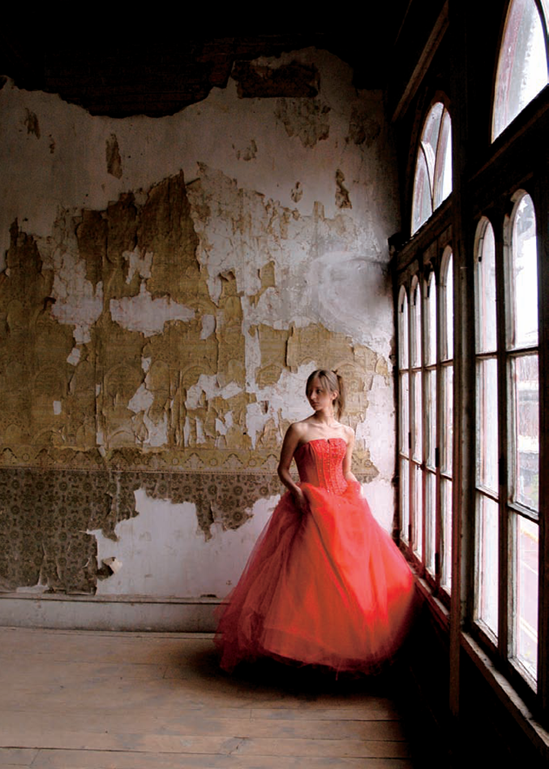
"Awaiting"
© Gordon R. Wenzel
Danville, Pennsylvania www.impressionsphoto.net
A portrait can tell a story when you put a subject in an interesting setting, such as this one, which blends new and old elements to make a statement about a former dance hall. When planning a portrait like this, keep it as simple as possible. Pictures that work best are those that convey their message quickly. Include only the elements that serve to make your intended statement. This photographer kept the composition simple and included just enough of the background to tell a story. The light coming in through the window serves as flattering illumination for the model, and her red dress is a welcome bright spot amid the drab interior.
"It is believed that the abandoned loft on the third floor of our studio was once a beautiful dance hall for a lodge in the late 1880s. Now, the ornate wallpaper with its North African motif is tattered and torn, which was the perfect setting to create a photograph of a model in a prom gown, reminiscent of a bygone era. Although much has changed in the time since, the juxtaposition of past and present speaks of the transient nature of beauty and the profound choices that must be made in any age regarding the future that awaits."
Nikon D100 digital SLR
Nikkor 18–70mm zoom lens set at 18mm
1/60 of a second at f/4
ISO 640
Natural window light
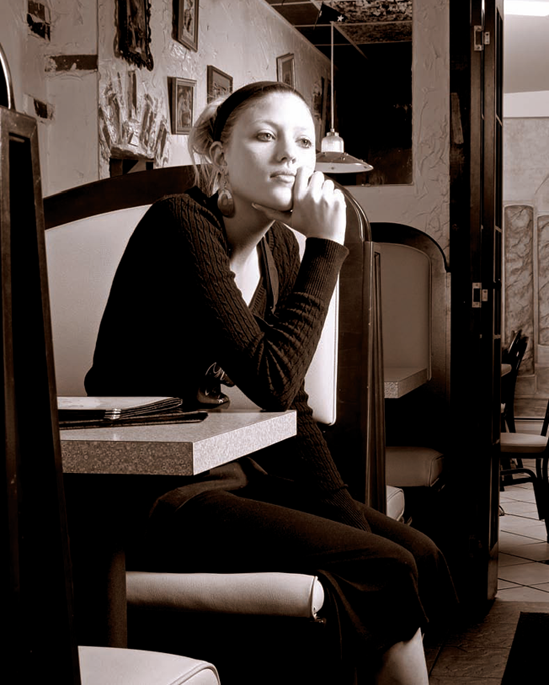
"Counter Culture #17"
© Robert Michael
Hackettstown, New Jersey
Some of the most revealing portraits are those that show what a person does for a living. Nearly every occupation has a distinctive tool, setting or clothing that can be used when photographing a person at work. As most workplaces are indoors, this may necessitate a flash or studio lighting, as this photographer used in his photo series about service personnel in a particular town. When you're making a statement about the person's surroundings at work, you may want to use a wide-angle lens. But in potentially hazardous places like construction sites, you need to keep your distance and use a long telephoto lens. Remember that at many workplaces, you probably need to get permission before you begin shooting.
"'Counter Culture' is an ever-evolving series of portraits. In the beginning, the goal was to represent people on the verge of their dreams, yet still doing what was necessary to survive. Counter Culture has emerged as a portrait of a town and a time, as a salute to those who make life better for us all. These subjects make our daily coffee, prepare our food, service our cars and build our kitchens. Some subjects are business owners, others work to get by until their dreams are realized. These are the people who make a town interesting and unique."
Canon EOS 1Ds Mark II digital SLR
Canon EF 50mm f/1.8 lens
1/60 of a second at f/8
ISO 100
Hensel softbox main light set at f/8, umbrella fill light set at f/2.8

"Michael"
© Jody Gomez
Murrieta, California www.jodygomez.com
Taking indoor photos can be a challenge, particularly because of the relatively dim light. You can always use flash, but if the conditions are right, you can get great images of people using soft, indirect light coming in through a window. Sometimes light from a window can be very directional, and the shadow side of a subject's face may appear too dark. One solution for this is to use a reflector, or position your subject so that their face is turned towards the window. In this portrait, the soft light wraps around the boy's face nicely and renders soft shadows (sometimes called "modeling") on the shaded side. Harsh, on-camera flash would destroy this pleasing effect.
"My 13-year-old son, Michael, and I were on our way home from a mountain bike race in Sonoma, California. We decided to stop in San Francisco and spend the day exploring the city. We stopped at a wonderful Italian restaurant on the pier. While waiting for our food, Michael and I amused ourselves by taking silly photos of each other and watching the fish in the harbor. It was then that I noticed the light from the window kissed Michael's face in a way that reminded me of all the sweetest moments I have ever experienced as a mother. I wanted to capture the essence of our perfect day and those sweet moments, and this image does just that."
Canon 20D digital SLR
Canon EF 24–70mm f/2.8L zoom lens set at 63mm
1/30 of a second at f/2.8
ISO 100
Window light
This portrait of an elderly woman is very successful because of the photographer's use of soft, diffuse light coming in through a window. The shadows in this photograph serve to create a frame around the subject's face, which is full of character. One of the primary ingredients in taking a good photo of an older person is the quality of light. Direct light brings out every line and wrinkle, so you may want to avoid this harsh type of illumination unless you want to emphasize the passage of time. Diffuse light, on the other hand, softens lines. This light is more flattering to a subject without concealing the effects of age that reveals an older person's character and experience. To flatter your subject even more, you might consider using a diffusion filter or adjust with image-editing software.
"Grandma"
© Monika Manowska
Nacka, Sweden
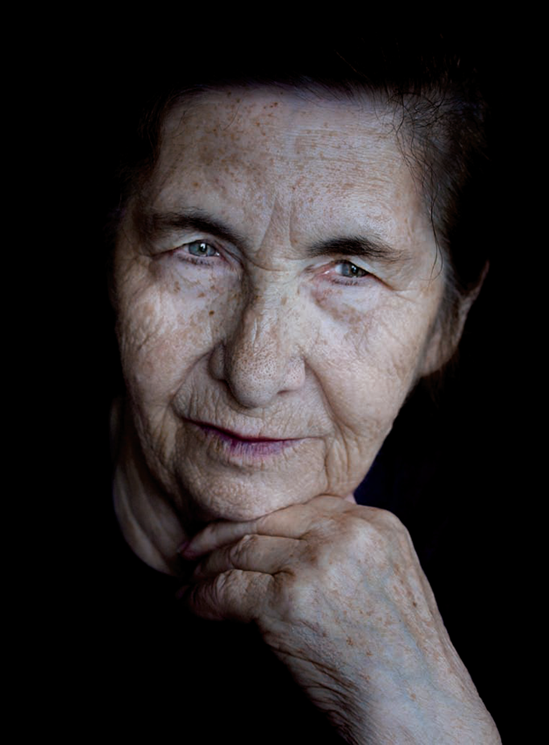
"This is my Grandma. She is 85 years old and I think she's so beautiful. She's had a long and hard life, but nonetheless, she is still a strong person who travels and runs around like a 60-year-old woman. She never gets tired. I wanted to show her beauty and the good that you can see in her eyes. I took this photo in my living room with window light coming in from the right, and the sun outside created a nice shadow in the room. I also like the catch lights in her eyes."
Canon EOS 350D digital SLR
Canon EF 60mm macro lens
1/250 of a second at f/2.8
ISO 800
Window light
As joyful occasions that bring family and friends together, weddings offer many opportunities to take pictures. In most cases, you shoot both candids and portraits. Because weddings progress in a predictable manner, you should plan what you're going to shoot and where to position yourself beforehand. Start with the bridal party getting ready and the nervous groom before the event, ending with the reception. Digital imaging offers the versatility of shooting at a high ISO indoors, where you may have to shoot without flash, to outdoor locations where you can use a slower ISO. But unless you are the photographer hired to shoot the wedding, always stay out of the professional photographer's way. Take your photos only when he or she is finished.
"I was taking black-and-white candid images for a wedding that was being formally photographed by a friend of mine. He gave me the opportunity to take some pictures, as he knows the kind of portraiture I enjoy doing. The lighting for this shot was extremely harsh; a brightly colored room, fluorescent ceiling lights and a very small area for dancing. The bride and groom didn't dance for very long and I managed only three shots, the best of which is 'first dance.' At the time I took it, I felt that I had gotten the shot I wanted."
Pentax MZ50 SLR
Pentax 35–80mm Zoom lens
Kodak T-Max 3200 black-and-white film
Exposure unrecorded
Available light
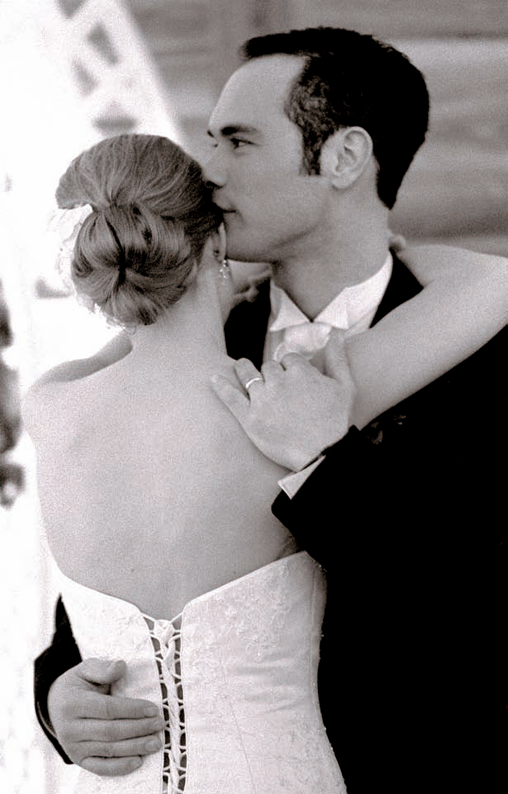
"First Dance"
© Heather Maslen
Anchorage, Alaska http://heathermaslen_photography.photoworkshop.com
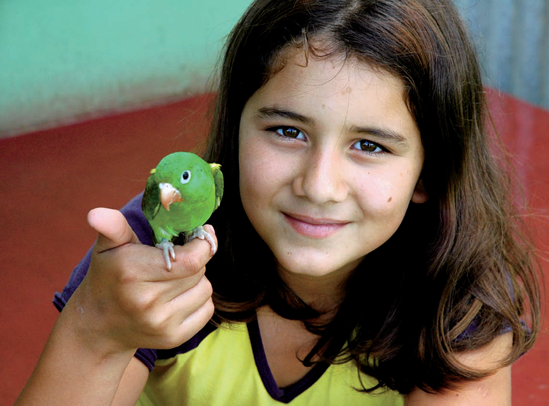
"La Nina"
© Christine McDonough
Salt Lake City, Utah www.ChristineMcD.com
You can capture an appealing, unself-conscious photo of a child when you choose an appropriate, uncluttered setting. Encourage him/her to get involved with an activity, or with a prop or pet, like the parrot that this little girl shows off proudly. All of the colors work well in this image too, from the blue hues in the background to the child's yellow top and green parrot, which is set off nicely against the red floor.
"In the summer of 2006, I went with a group to Costa Rica on a Habitat for Humanity Global Village build. For a week, we worked daily with the families who were to live in the homes we helped build, and found some of the most congenial, hardworking, and beautiful people. While we worked, we also played with the neighborhood kids, who had a most special kind of beauty and joy. The first Spanish phrase I used was 'Puedo sacar una foto?' (May I take a photo?), and most people in the neighborhood would see my camera, run over excitedly, and pose themselves or their children for many pictures. Everyone was eager to see their image on the digital screen, and they would laugh and giggle, then insist on posing for more!"
Nikon D70 digital SLR
Nikkor 18–70mm f/3.5–4.5G ED-IF AF-S DX zoom lens set at 65mm
1/160 of a second at f/6.3
ISO 800
Natural light
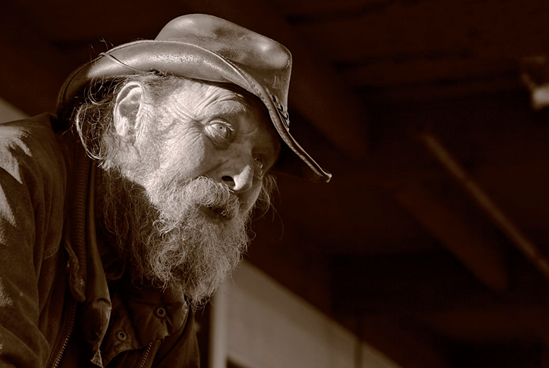
"Dan"
© Christian Goltz
Davis, California www.kiss-of-light.com
One of the biggest considerations when photographing an older person is lighting, and how you want to depict the individual. Harsh lighting from the sun or a flash tends to bring out every wrinkle on a mature person's face. Soft, diffuse light gently fills in furrows, but the lines of a person's face can also reveal character. This photographer captured his elderly subject with areas of both light and shade on his weathered face. The sepia tone also makes a statement about a bygone era. Interesting subjects like this one don't come along that often, and the photographer quickly seized a great opportunity to capture a bit of history.
"I usually shoot landscapes. That afternoon, however, I was roaming around in Old Sacramento, a recreation of the Sacramento of bygone days. The buildings were nice, but what were missing were the people of Old Sacramento. Then I saw Dan, leaning on a wooden barrel and smoking a cigarette. I asked permission to photograph him, set my camera on continuous mode, and fired away. This frame was the only one in which he opened his eyes wide for a brief moment. I was lucky that the sun illuminated his eyes this way. Another photographer showed up and drove Dan away. I was only able to speak to him again some weeks later at the same spot. If Dan's face isn't a landscape, then I don't know what is."
Canon EOS 5D digital SLR
Canon EF 24–70mm f/2.8 L zoom lens set at 62mm
1/125 of a second at f/4.5
100 ISO
Natural lighting
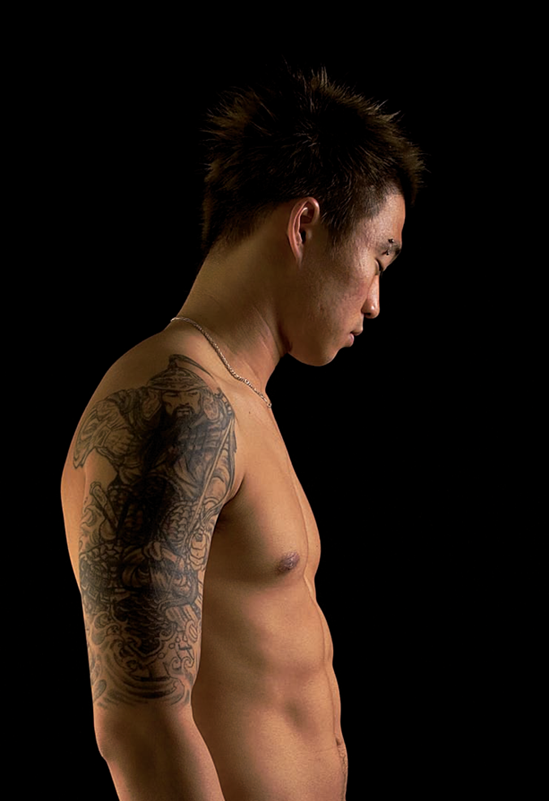
"Warlord"
© Roger G. Barry
El Sobrante, California
As the key ingredient in photography, light illuminates, shapes and defines subjects. The sidelighting from a studio softbox brings out shadow detail in this young man's face and body, while a tungsten light provides subtle lighting on his back. Straight-on light, like that of an on-camera flash, would have flattened the image. The photographer has chosen to light only the subject's skin, allowing his dark hair to fade gradually into the black background. Whether you choose to control light or to utilize the variations of natural illumination, you should learn to become sensitive to the emotional qualities of your photograph that derive from the way it was lit. Also, it's important to understand light and its effects well enough so that you know how the subject will look in the resulting image.
"I first saw Eugene celebrating with a group of young Korean professionals in Oakland's Jack London Square. My immediate vision was of a young warlord and his retinue. In reality, he is a stylist and this was an office party. The lesson: Don't let reality interfere with vision."
Canon EOS 5D digital SLR
Canon EF 35–80mm zoom lens set at 53mm
1/30 of a second at f/9.0
ISO 200
500-watt Lowell Tota light with Photoflex softbox for main light
1000-watt Tungsten worklight behind a cotton muslin gobo for light on the subject's back
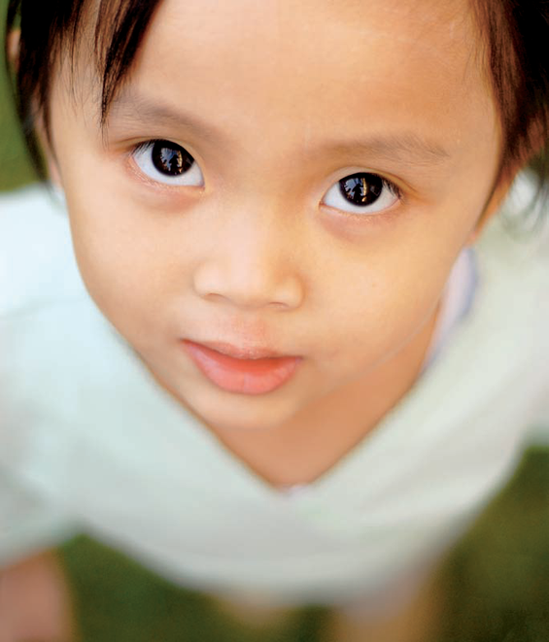
"Alani"
© Pei-Pei Ketron
Fremont, California www.penelopesloom.com
It's usually advisable to photograph children from their level, but in this case, the photographer purposely shot the image from above to emphasize the wide-eyed innocence of a small child. Shooting down from a high vantage point is a great way to show a child from an adult's perspective. She's used a wide-open aperture very effectively, which throws the rest of the image out of focus. As this appealing portrait reveals, it's a good idea to experiment with camera angles and levels when photographing children.
"I was photographing Alain's four-week-old baby sister, Ava, while Alani and her older sister Aubrey played outside. Ava became cranky and needed to be fed, so I took a break from taking her picture and went outside to photograph the two older girls. The light in the shade of the house was ideal for portraits. I wanted to get a shot of Alani that played up her eyes, so I stood on a lawn chair and asked her to stand directly below me so that I could look down on her. Using my 50mm lens wide-open at f/1.8, I focused on her eyes and took advantage of the shallow depth of field, allowing everything else to fall out of focus. I was able to get the shot I wanted — one where she is staring intensely at the camera with the wide eyes of a child."
Nikon D200 digital SLR
Nikkor 50mm f/1.8 lens
1/500 of a second at f/1.8
ISO 200
Open shade
The vantage point from which we choose to shoot a picture is important, yet we typically shoot from our own eye level. Next time you photograph someone, try moving around your subject, shooting from different angles. Try shooting down from a high position (as this photographer did), or shooting upward from a low vantage point. Move close and farther away. You'll probably discover some interesting shifts between your subject and the background, allowing you to make different statements about the environment you're shooting in.
"It's all in the face. I met Matt Pelliccia a few years ago during his graduate vocal studies at the University of Utah, while we were both cast in the Utah Opera chorus. We became friends, and often understood each other with a mere wink, crazy face, or pose. He now lives in New York, pursuing a singing career as a tenor, and I see him infrequently. He's one of those people with a liquid face, who can display or hide any emotion or thought. We were wandering through the Salt Lake City Main Library — an award-winning, architecturally stunning building — just taking pictures. Here, the library's fourth floor stairway leads up to the roof access level, and the lighting fell perfectly on his fantastic face as he looked up at me. The situation demanded I take a photo."
Nikon D70 digital SLR
Nikkor 18–70mm f/3.5–4.5G ED-IF AF-S DX zoom lens set at 48mm
1/30 of a second at f/4.5
ISO 1000
Natural window light
"MVP1"
© Christine McDonough
Salt Lake City, Utah www.ChristineMcD.com
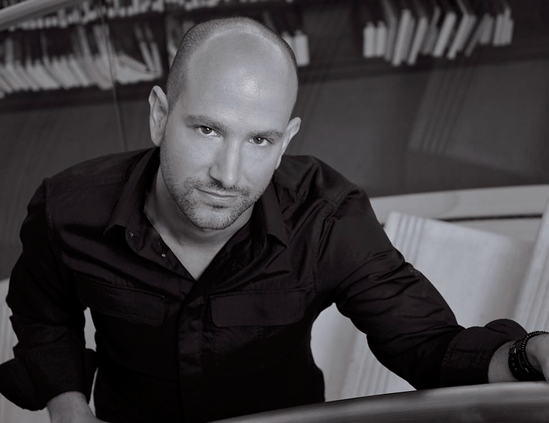
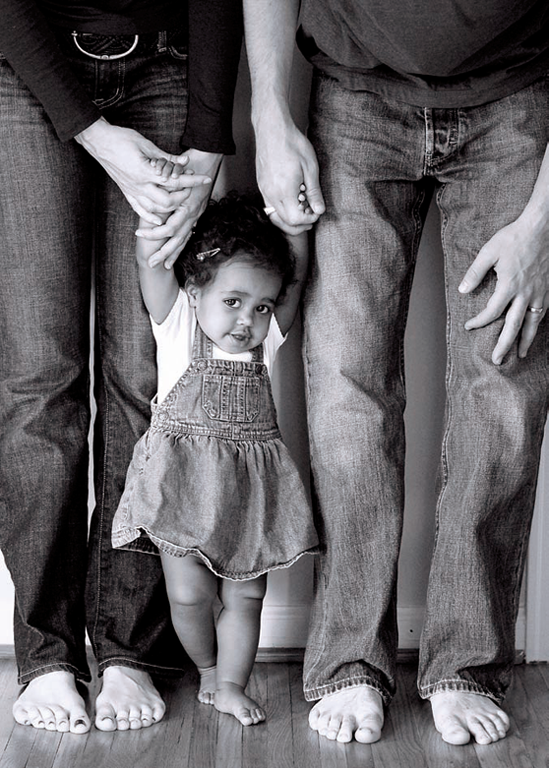
"Baby Steps"
© Stacy Wasmuth
Indianapolis, Indiana www.bluecandyphotography.com
There are several ways to emphasize the small stature of a child in an adult's world, like shooting down on a child from above. The photographer chose to focus on the shy-looking toddler in this picture, who is holding the hands of her parents who appear much larger by comparison. By moving down to the little girl's level, you get a sense of what life is like from her perspective. Also, you don't need to see the parents' faces to know that there's a lot of affection in this family, and this image conveys a sense of trust. This is a more striking family portrait than had the photographer taken a traditional approach.
"Sometimes bits and pieces of a portrait can tell a big story. I especially enjoy "feet" family portraits because they convey both a small child's size and view of the world. For this image, I chose a plain wall and floorboard as a simple backdrop and relied on a window behind and to my left as the light source. It was early in the photo shoot, and the toddler was still slightly apprehensive of me and my camera. I asked both parents to hold their daughter's hand as she stood. Once she found herself securely placed between mom and dad, she felt comfortable enough to flash a shy grin at me. The result was adorable!"
Nikon D200 digital SLR
Nikkor 50mm lens
1/250 of a second at f/3.2
ISO 640
Natural light

"Joy"
© Dan Barnett
West Palm Beach, Florida http://danbarnettphoto.com
Photographing a parent and child together is always rewarding, as the relationship between them is unlike any other. In most cases, infants and toddlers can be easily photographed on their parents' laps or in their arms. However, try to avoid shooting a snapshot that looks too static. You can break out of this mold by exploring what's special about the parent-child relationship that you're photographing. Do they enjoy a particular activity? A father and son fishing together, for example, can yield some great candid moments. This delightful image expresses a toddler's gleefulness at being tossed up in the air by his father. And you can't help but smile at this wonderful photo, which takes family portraiture a step beyond by capturing a precious moment that can't easily be recreated.
"While photographing a family portrait session at the beach, I suggested that the father toss their little son, Charlie, into the air. As a parent of four, I knew that kids at this age love to 'fly' like this. Whenever I work with families, my job is not simply to shoot nice pictures that the client will be happy with for a week after the photo session. Instead, I'm creating heirlooms that will be cherished for generations. My inspiration is to create an image that will be treasured long after I'm gone."
Canon EOS 1D Mark II digital SLR
Canon EF 17–40mm f/4.0 L zoom lens set at 17mm
1/800 of a second at f/8
ISO 200
Natural sunlight with fill-flash from a Canon 550
EX Speedlite
The tight composition of this woman's face and shoulders conveys a feeling of intimacy. And the studio flash creates a soft light that dissolves into just the right amount of soft shadow and "modeling" on the opposite side of her face. Revealing only a small part of the body and the mere suggestion of nudity can also be very sensuous, as this photographer indicates. To be effective, this type of image should be simple and uncluttered to convey a feeling about the subject's mood and individuality. The model should also feel relaxed and appear natural in front of the camera. The background you choose is important and can help to express the feeling you want to get across.
"When I was working as a fashion photographer, I occasionally crossed over into glamour photography, and discovered that it didn't do much for me. I decided that instead, the allure of shooting nude photos has something to do with the anticipation. The most important part of a photograph can be the bits you fail to reveal. This image, for example, is a standard head-and-shoulders portrait that works particularly well because it looks as if the model might be naked (but she's not — her top starts a fraction of an inch below the frame of the photo), which adds an extra layer of complexity and titillation."
Canon EOS 30D digital SLR
Canon EF 28–135mm f/3.5–5.6 IS Zoom lens
1/60 of a second at f/9.5
ISO 100
3X Bowen 500W flashguns

"Lucy"
© Haje Jan Kamps
London, England www.photocritic.org
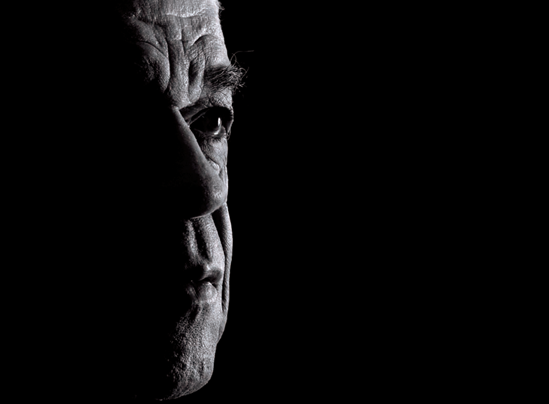
"My Uncle, My Friend"
© Jim Williams
Winston-Salem, North Carolina www.creekridgestudio.com
Subtle differences in lighting and other elements can change the feel of an image altogether. In order to want to emphasize a particular mood, you must make certain creative adjustments. You need to learn to visualize what your picture will look like so that you can successfully manipulate its mood. One way to do this is by changing the light. This dramatically sidelit, shadowy portrait imparts somewhat of a melancholy feeling. Only a small portion of the subject's face is illuminated, just enough to reveal a little about his character. This is a very powerful image.
"As the title suggests, he was more than my uncle, he was my very best friend. When I took this photo, he was 88 years old. Unfortunately he passed away less than a year later. I can see his wisdom and kindness in the photo, which brings to mind all of the special times we shared. I am a very lucky man to have grown up with not just one father, but two who loved me dearly."
Nikon D70 digital SLR
Sigma 70–300 D APO zoom lens set at 120mm
1/80 of a second at f/13
ISO 200
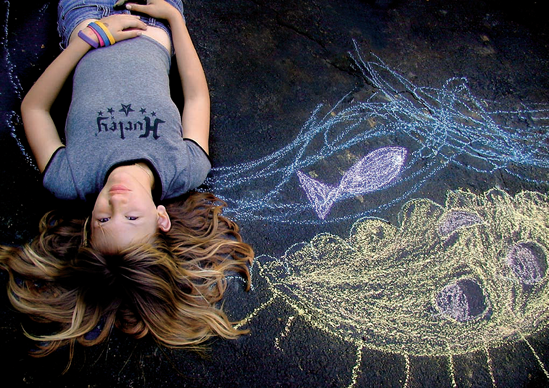
"Mermaid"
© Debra Tomaszewski
Kentfield, California www.debratomaszewski.com
Including something of a child's environment or interests makes a statement about his or her individual personality. To capture a child's world, you must avoid imposing an adult's view of children. Instead, look for activities, toys or locations that offer interesting information about kids. As this photo demonstrates, shooting an image of the little girl with her artwork is very intriguing because her drawing tells us a lot about the talent and imagination of this youthful artist. This image is even more creative because the photographer chose to photograph the little girl from above, upside-down next to her colorful work. When you take pictures of a child and his or her environment, it's best to use a wide-angle lens to encompass all of the important elements of a scene.
"My 11-year-old daughter was drawing with side-walk chalk on our driveway when she created this sketch of a fish swimming in the ocean with a happy sun in the sky. I asked her to lie down next to it so that I could take a picture. Her hair spread out and she looked like a mermaid under the water. I loved the contrast of the child-like drawing next to the budding adolescent. It was the perfect metaphor: My 11-year-old daughter was growing up and swimming away as the world and I smiled down on her. I quickly clicked the shutter."
Olympus Camedia C-2000Z digital SLR
Built-in AF 6.5–19.5mm zoom lens
1/250 of a second at f/2
ISO 100
Natural light
Of course, the main focus of a wedding is the couple, particularly the bride. Many photographers photograph the bride alone in a portrait before the ceremony. In this lovely image of a bride on her special day, the photographer decided to utilize the architecture of the hotel and consequently, the city where the wedding was to be held. It provides a great backdrop besides showing the setting of the event, as well as the surrounding architecture. By using only the diffuse window light coming in through the window, the bride is rendered almost in silhouette, except for her beautiful white gown. This image probably serves as one of the couple's fondest memories in their wedding album.
"As I started to do more destination weddings; I was hired to this one in Charleston, South Carolina. The wedding was held in a beautiful downtown hotel with great architecture. This image was taken in the room where the girls were getting ready. I saw this door and positioned the bride in front of it and shot several frames. The wedding was an elegant, yet simple event, and this image reflected the romantic feeling of the entire day. Laura was a gorgeous bride who worked very well in this spot — the image takes on a classic — almost fashion-like — pose and feeling."

"Laura"
© Todd Kuhns
Kettering, Ohio www.studio12online.com
Canon EOS 20D digital SLR
Canon EF 17–40mm f/4 lens set at 29mm
1/60 of a second at f/4
Ambient light
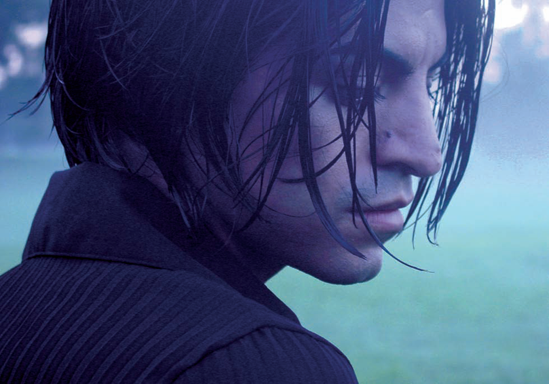
"Blue"
© Edna Eudave
Anaheim, California www.squareeyephoto.com
When you want to accentuate emotion in a photograph, you can purposely enhance your subject's mood. Manipulating the mood of an image means making certain creative adjustments like changing the light, utilizing a particular point of view, or cropping your image to alter the spirit of a photo. In this example, the photographer successfully enhanced the "blue" mood of her subject by using the cool tones of a foggy day with lighting, cropping closely on her subject's face, and capturing him with downcast eyes.
"My best friend is constantly asking me to take pictures of him — he's quite vain, but I love him. I didn't have any of my pro equipment with me at the time. All I had was my little Sony Cybershot, but I've always been able to make miracles happen with amateur equipment. I'm a huge Michael Kenna fan. I love the dark, foggy gardens that he has photographed, but because I don't like shooting landscapes, I try to translate this style into portraits. We were at Mile Square Park in Fountain Valley, California, and I knew that it would be foggy until shortly after dawn. I shot about 50 images of him that morning and liked many of the portraits, although this was definitely my favorite. I actually painted this in oil on a large canvas, and it sits on an easel in my living room."
Sony Cybershot compact digital SLR
Built-in lens set at 100mm
1/40 of a second at f/2.4
ISO 100
Ambient light on a foggy morning
Our families are usually our most frequently photographed subjects, and we treasure these photos more than others. We shoot pictures at weddings, of family gatherings, and of course, of our own children. We start taking pictures of them from the time they're born and document important milestones thereafter, on up to graduation and their own parenthood. As I mentioned earlier, it's important to have a camera with you at all times to document these precious times. And, because your family knows and trusts you, you'll have the opportunity to shoot lots of pictures of them and experiment with cameras, lenses, and various photo techniques. Close-up shots are always a great way to really capture a child's personality.
"This photo was taken last fall when I was out with my two daughters at the park. I was trying to take some pictures for Christmas cards when my younger daughter, Grace, gave me this look. I think it really captures the mischief and innocence in the eyes of a seven-year-old having fun with her sister."
Canon EOS Digital Rebel XT
Canon EF 50mm lens
1/3200 of a second at f/2.2
ISO 800
Natural light
"Grace"
© Kristi McCluskey
Lenexa, Kansas
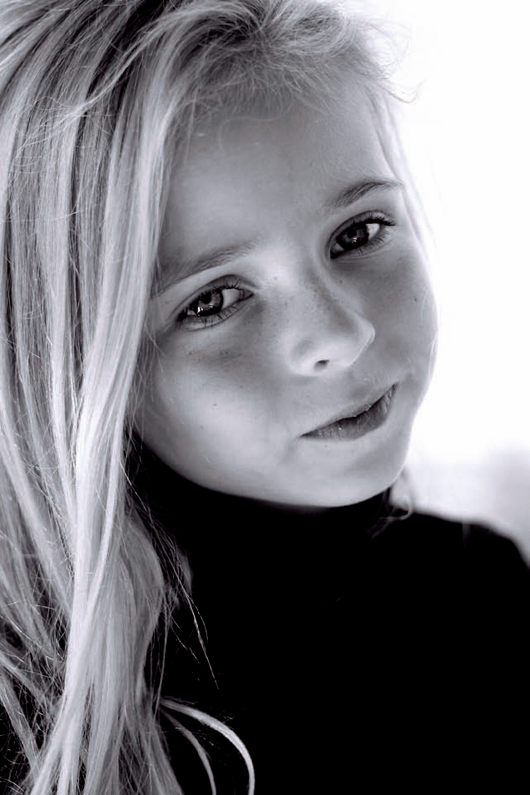
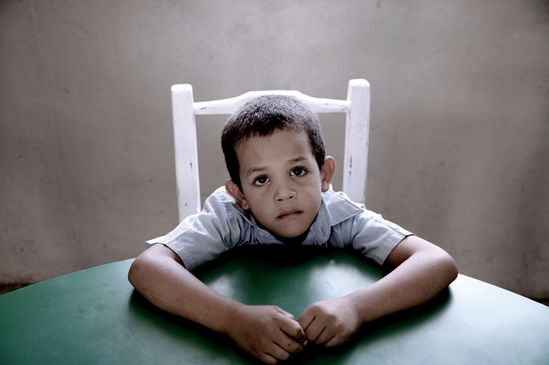
"School Kid in Dominican Republic"
© Timm Vladimir
Denmark www.globaleye.dk
Children as photographic subjects can be endlessly fascinating. Unlike adults, they're non-pretentious, spontaneous, and curious. In this informal child's portrait, the photographer has included just enough of the simple setting of a classroom to form a pleasing, non-distracting visual composition. The boy also appears to be very small, sitting at a table made for adults. You can also use architectural details like doors and windows to emphasize the relatively small size of a child, as well as to provide framing elements. And, as you can see, you don't always have to ask a child to grin for the camera in order to get an appealing photograph. Remember that children's attention spans are brief, so be prepared to work quickly.
"While traveling through the Dominican Republic, I visited a school sponsored by the fair trade system in a poor, banana farming community. Without the fair trade money, schools wouldn't exist in areas like this one. The first student I photographed was this little fellow. He looks a little apprehensive, but then again, the only white man that these children were used to seeing was the local doctor. So the boy thought I was there to give him a shot. And in a way, you could say I was."
Canon EOS 1Ds Mark II digital SLR
Canon EF 24–105mm L series IS zoom lens set at 50mm
1/60 of a second at f/4.5
ISO 320
Ambient indoor light
"Self Portrait"
© Denny Mack
Austin, Texas http://deadsailorproductions.com
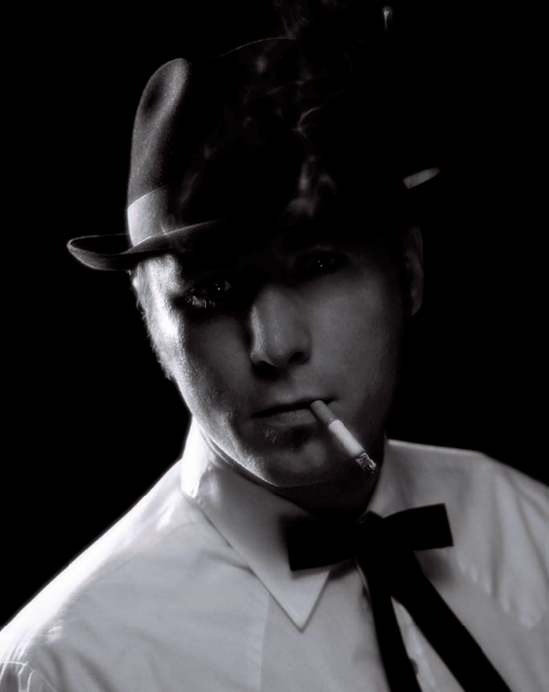
Many people who love shooting portraits create a self-portrait at some point in time. Usually, these images say something about the photographer's personality. But you can also make a statement by acting out a role, as this photographer did. In learning how to render his models as classic movie stars, he practiced the lighting and style by photographing himself in this manner.
"At the time I took this photograph, I was deeply interested in the old Hollywood-type portraiture as done by photographer George Hurrell and the lighting of film noir motion picture directors, Robert Siodmak and John Huston. I was captivated by their use of dark backgrounds, directional lighting and the way the shadows and highlights gave the images an air of mystery. I planned to do this type of photo shoot, so in order to be prepared for the models, I set up my camera on the tripod and did some test shots of myself using the self-timer. In this shot, I used one flash set up at camera left, just behind my right shoulder. I also modified the light by using a small umbrella to soften the light just a bit while retaining a strong directional quality. On my right side, I clamped a reflector to a light stand to reflect some of the light onto my face."
Nikon D200 digital SLR
Nikkor 50mm f/1.8 lens
1/250 of a second at f/1.8
ISO 100
Spot Metering
Smith-Victor Flashlite 200i with shoot-through umbrella

"The Eye"
© Atle Garmann
Bergen, Norway http://atlegarmann.photoworkshop.com
A good photographer can snap an appealing portrait in a variety of situations. Although the photographer planned this image carefully and used an off-camera flash, this subject appears fresh, spontaneous, and unposed. When shooting informal portraits, you may want to try to use available light as effectively as possible. Indoors, you may want to utilize available light in addition to flash, as this photographer did because he was shooting at a slow shutter speed. Outdoors, you can use the ambient light of an overcast day or open shade to illuminate your subject's features evenly. Simple backgrounds always work well. Here the background is a natural reflector, adding to the cheerful nature of the portrait.
"Last year I went to school in Bergen, Norway, to learn digital photography. One of our homework assignments was to use one of the rules of composition and to do one thing wrong. I used the Rule of Thirds and decided to put the eye you don't see straight into the upper left intersection of the first two lines. The composition works well despite breaking the rules. This beautiful lady is one of my classmates, Elin Anderson, who is a skilled photographer."
